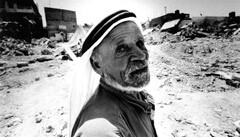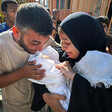The Electronic Intifada 30 June 2008

A still from Ryuichi Hirokawa’s film, Palestine 1948 Nakba.
After finding the white stones, Hirokawa connected with the socialist anti-Zionist Matzpen group in Israel and joined them in their struggle against Israeli oppression of the Palestinians. Hirokawa found his answer in one of their maps — a Zionist-appropriated British map that had the names of the Palestinian villages destroyed during 1947-48. Underneath the Hebrew name Kibbutz Dalia was the Palestinian name Umm al-Dafuf, with the Hebrew word for “destroyed” stamped upon it. The kibbutz was also built on the land of the Palestinian village Dalia al-Rahwe.
Upon this discovery, Hirokawa set out to find the villages’ inhabitants. This search took Hirokawa to Beirut, where he was one of the first to document the massacre in Sabra and Shatila refugee camps perpetrated by the Lebanese Phalangist militia with the collusion and under the watchful eye of the Israeli army that surrounded the camps. This experience would propel his celebrated career in journalism. Hirokawa’s search also introduced him to Israel’s internally displaced Palestinians, and led him to the besieged West Bank where he finds that the occupation breeds a cycle of intensifying resistance that is met with increasingly brutal Israeli oppression.
It is through the footage and photographs he took throughout the last forty years that Hirokawa tells the story of constant Palestinian displacement. He also demonstrates to the viewer that concurrent with the Palestinian story of displacement is the Israeli history of constant destruction. The imagery of Sabra and Shatila after the massacre and shelling in 1982 is not that different from the imagery of bodies being pulled out from under the rubble of Jenin refugee camp, attacked by Israel in 2002, nor the imagery of Beirut’s southern suburbs a few years later, ruthlessly bombarded by Israel during its summer-long war on Lebanon.
“Many facts of 1948 remain hidden,” the audience learns as the film opens with archive images of the Palestinian dispossession by Zionist forces. Collective Israeli denial allows these facts to remain buried — sometimes quite literally. When Hirokawa interviews Kibbutz Dalia residents about what used to be there before its founding in 1939, one man seems puzzled by the question and responds, “a tree.” He adds, “one tree and many stones,” though he doesn’t stop to consider who might have placed those stones on top of each other to form walls and buildings whose remains are still clearly visible.
Another resident recounts how when she was a child, the residents of the Arab (Palestinian) village next to the kibbutz left in the middle of the night, never to return. The kibbutz residents “thought the whole village just vanished” overnight, as if the the matter required no more serious thought than that.
Of course, when Hirokawa finds the village’s original residents, a very different story emerges. Decades later, the residents remain traumatized by their departure. One Dalia al-Rahwe resident in Jenin can barely articulate his story, the memories are still so painful. He explains that villagers knew that when the village was attacked by militiamen from the kibbutz, “only the luckly would survive.” He recalls, “People were afraid to come out during the day,” and they planned to flee at night. However, “[Dalia al-Rahwe was] attacked at night, then the village was blown up.”
Hirokawa’s interviews with the original residents of Dalia al-Rahwe and other destroyed villages, as well as supporting interviews with Palestinian and Israeli historians, demonstrate that the destruction of historic Palestine and the displacement of its residents was not the accident of war. Instead, one can only conclude, the massacring of villages — which were then blown up, sometimes as the residents watched from the hilltops to which they had fled — was the strategy of the Zionist leaders to ethnically cleanse historic Palestine to make way for the establishment of a Jewish state.
The film also makes clear that wherever they ended up, Palestinians took their memories, if not their possessions, with them. An interview with a young Palestinian historian in the West Bank town of Tulkarem demonstrates how continued Israeli oppression has affirmed amongst young Palestinians the experience of their parents’ generation. As a child Mohammed Tanzi was skeptical of his father’s recollections of what happened to his coastal village of Tantura. He explains that it was Israel’s brutal repression of the first Palestinian uprising in the late 1980s that made him appreciate his father’s story. Mohammed has since painstakingly recorded the testimony of the survivors of the massacre that took place in Tantura between 22-23 May 1948, when men from the village were rounded up and executed as their family members looked on (“They took them alive and brought them back dead,” Mohammed’s father Fawzi, a survivor, repeats). The site of the mass grave where nearly 300 murdered villagers now lay is currently a parking lot for a sandy beach enjoyed by Jewish Israelis from Tel Aviv.
Hirokawa worriedly narrates upon the film’s conclusion that there are “fewer and fewer with memories of [the] destroyed villages,” implying that the Palestinian national movement will suffer. However, his own film belies this, as we meet Kifah Afifi, who was born in Shatila refugee camp and was tortured for four years in Khiam prison, the infamous detention center controlled by the Israeli occupying army as well as its proxy force, the Southern Lebanese Army, during Israel’s long and bloody occupation of Lebanon. By joining the Palestinian resistance, she was prepared to die for a country she had never seen. Though she is no longer fighting, contemporary footage finds her living something closer to a middle-class life in Beirut, with a young family to whom she will surely pass on her family and her people’s story, chronicled so movingly by Hirokawa — ensuring the preservation of the Nakba memory in spite of all that’s been done by Israel to bury that history.
Maureen Clare Murphy is Managing Editor of The Electronic Intifada.
Palestine 1948 Nakba has screened in Beirut and its North American premiere was at the 2008 Chicago Palestine Film Festival. The above review is of the 131-minute version of the film.
Related Links




